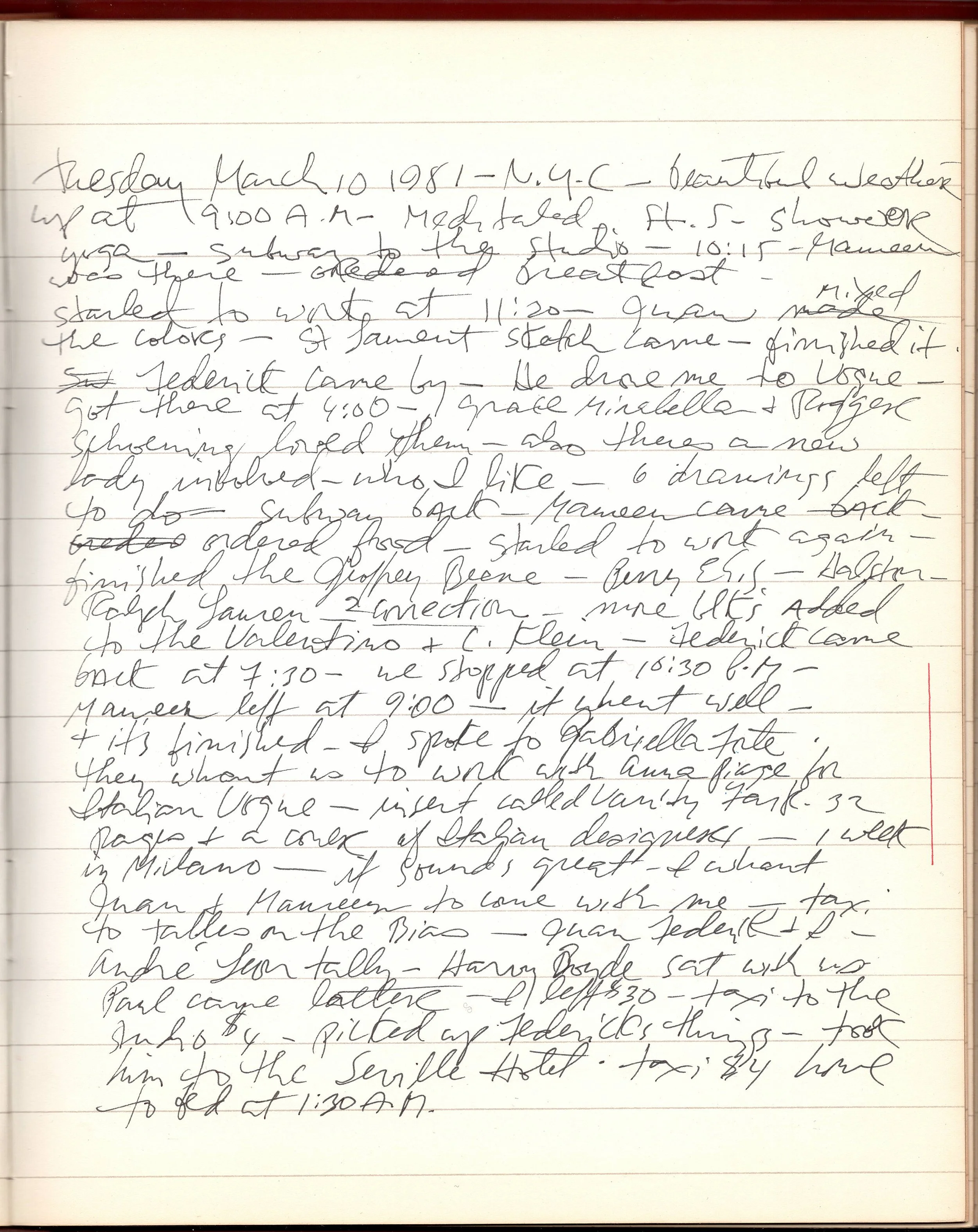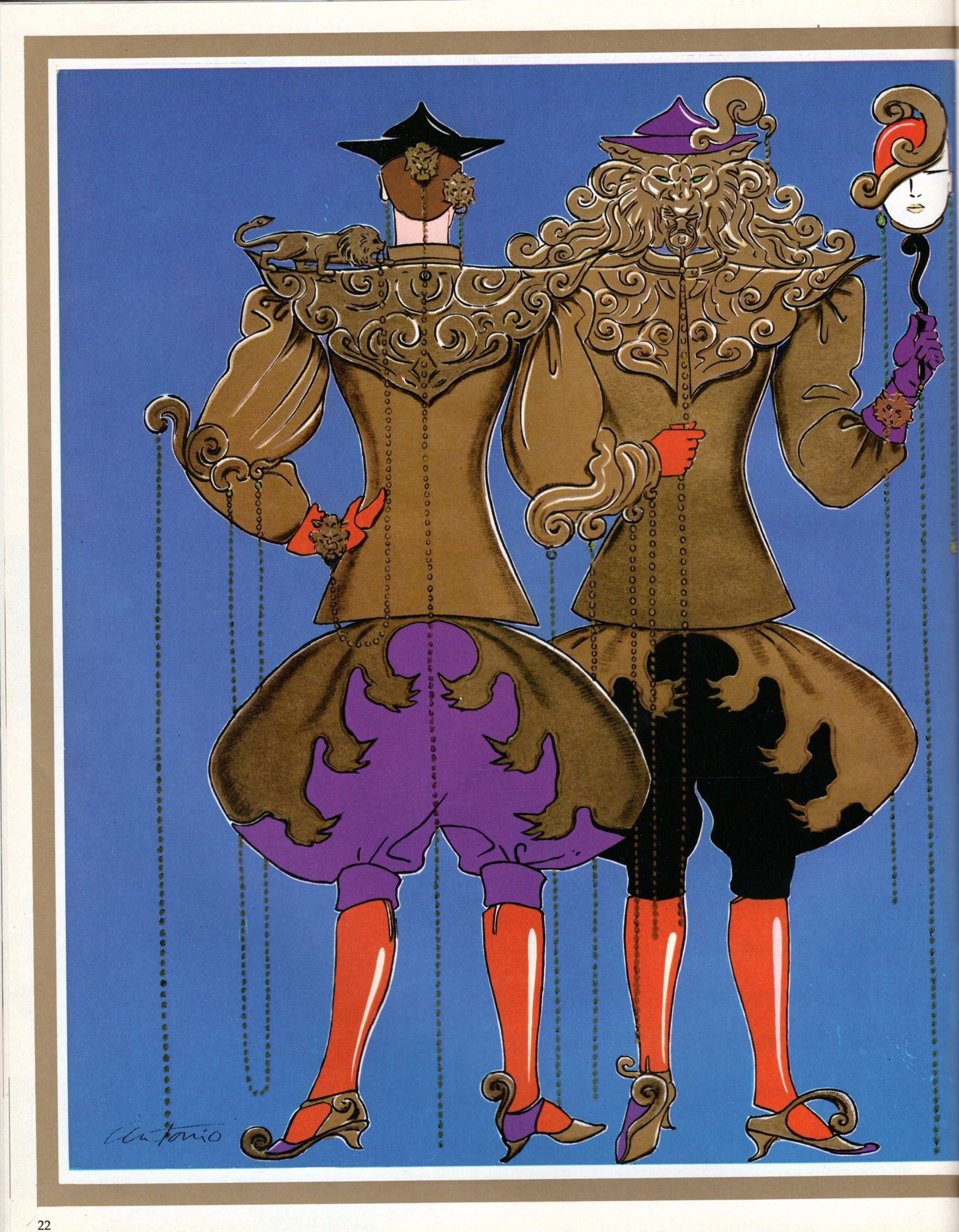Vanity
Anna Piaggi and Antonio Lopez working on Vanity magazine, Milan, 1982
In 1981, the renowned Milanese fashion editor, writer, and style icon Anna Piaggi founded the short lived but highly influential Vanity magazine.
The inaugural issue was produced as an insert for the September 1981 Vogue Italia and focused exclusively on Italian designers. Anna juxtaposed bold full page artwork with graphic text, and styled the fashion with theatrical flair. It was an approach that set Vanity apart from the era’s mainstream publications of Vogue, Marie Claire, or Elle.
At this time in publishing, photography had already begun to supplant illustration as the medium of choice, but as Piaggi described to Blitz magazine in 1987:
“It was a chance to step out of photography…I wanted to express the idea of fantasies, but the clothes were all tied up with advertising, so to give [them] a new spirit, I commissioned illustrators.”
The title was originally presented as a “concept magazine,” but soon after its release Condé Nast green-lit Vanity to run as an independent quarterly publication.
It ran from 1982 until 1989, and went on to encapsulate a decade of social and sartorial transformation. Anna’s discursive style was a revelation, and from the start, she framed Vanity as a collaboration with Antonio and Juan, presenting the first issue as a portfolio of their work.
Antonio’s self portrait filled the cover above a single title that read “48 pages of Italian ready-to-wear illustrated by Antonio Lopez.” The interior cover featured another portrait of Antonio, this one drawn by Karl Lagerfeld, with a corresponding text that describes A & J’s contribution to the magazine: “With 40 drawings and 200 polaroids - partly published, partly used only for the preparatory phase - Antonio Lopez, illustrator, with the very close collaboration of Juan Ramos, colorist-photographer, have created this entire issue of "Vanity Fashion." It was for Antonio and Juan an "Italian moment," 20 days and 20 nights [in Milan], and one of the most interesting and stimulating of their long partnership as artists. Antonio was the first of the contemporary illustrators to transform the fragile , filiform, stylized images of fashion illustrations in human figures pulsating with flesh and muscles, starting from the Léger period, through pop, psychedelia, Californian culture, easy riders, gladiators and above all the stars he discovered and visualized.”
Antonio’s Diary
Tuesday March 10, 1981
New York City
Beautiful Weather
Up at 9am. Meditated. Shower. Yoga. Subway to the studio – 10:15. Maureen was there. Ordered breakfast. Started to work at 11:30. Juan mixed the colors – Saint Laurent sketch came – finished it. Frederic came by – he drove me to Vogue – got there at 4. Grace Mirabella and Roger Schoening love them – also theres a new lady involved – who I like – six drawings left to do. Subway back. Maureen came back – ordered food. Started to work again, finished the Geoffrey Beene – Perry Ellis – Halston – Ralph Lauren 2 correction. More blacks added to the Valentino and Calvin Klein – Frederic came back at 7:30 – We stopped at 10:30 pm. Maureen left at 9. It went well and its finished. I spoke to Gabriella Forte – they want us to work with Anna Piaggi for Italian Vogue – insert called Vanity – 32 pages and a cover of Italian designers – one week in Milano. It sounds great – I want Juan and Maureen to come with me – taxi to Tables on the Bias Juan Frederic and I, Andre Leon Talley – Harvey Boyd sat with us. Paul came later. I left $30 – taxi t the studio $4 – picked up Frederic took him to the Seville hotel. Taxi $4 Home and to bed at 1:30.
On the cover, Anna Piaggi is the self proclaimed curator of Vanity. It’s a title that places her beyond the world of publishing — and the work of Antonio, Juan, and the designers featured in her pages, as artists rather than fashion specific creatives.
At the time of Vanity’s publication, A & J were at the peak of their career. Among audiences and industry leaders they were globally recognized for their highly researched and boundary pushing approach to fashion illustration. In their personal practice they had begun to produce a large body of portraiture work, experiment conceptually with photography, and were taking on additional creative pursuits such as publishing their first book Antonio’s Girls, in 1982.
Likewise, for Italian designers, the dawn of the 1980s was monumental. Held back by years of post war financial struggles, the country finally came into its own as a contemporary powerhouse. Centered in Milan, the Italian fashion scene provided a counterweight to the refined elegance of Parisian couture and new wave American sport-chic. Additionally, the government’s “Made in Italy” campaign — which promoted the cultural excellence of Italian exports — had created a renewed interest in the fashion and design emerging out of the European hub.
Vanity’s first issue leans into this new found popularity, showcasing a cross section of heritage and up and coming Italian fashion houses through the unique creative lens of Anna. Antonio, and Juan. Missoni’s iconic fabric is rendered with fervent watercolor splatters across a reclining model. Giorgio Armani’s sharp tailoring is reinterpreted in the style of Victorian artist Richard Dadd, with the fabric’s pleats drawn in photorealistic detail and transposed onto a surreal scene of armadillo models. Gianfranco Ferré, Versace, Fendi, Walter Albini, Soprani, and Krizia, all appear within the first edition.
Following Vanity’s inaugural launch, Anna brought Antonio & Juan on as the ‘in house’ illustrators for the critical first issues, flying them to Milan for multi-week stints where they would set up a make shift studio and brainstorm ideas with Anna, her creative partner Vern Lambert, her husband and photographer Alfa Castaldi, and others.
For Antonio & Juan, Vanity provided the perfect middle ground for experimentation and growth. They were able to use the visual language of fashion and illustration in which they were so well versed, yet simultaneously produced seminal artworks that explored race, gender, and sexuality, incorporated pop culture and art historical motifs, and allowed them to experiment with styles and technique.
"Be-bop e pionieri," featuring Anonymous models wearing Krizia and Versace. Published in the January 1982 issue of Vanity.
"Digina Memoria Valentino!," featuring Maria Snyder as Joan Crawford wearing Valentino, Rene Caovilla for Valentino, Ugo Correani, and Omsa. Published in the July 1982 issue of Vanity.
"High Dandy," feauting Mike Haire wearing Elsa Peretti for Tiffany (left) and Paloma Picasso for Tiffany (right) Published in the October 1982 issue of Vanity.
“Karl Lagerfeld per Chloe" featuring Paloma Picasso and Anonymous model wearing Karl Lagerfeld for Chloe, Ugo Correani, Omsa, Santini & Dominici. Published in the October 1983 issue of Vanity.
"Gianni Versace Asimmetricamente" featuring model Maria Snyder wearing Gianni Versace and Ugo Correani for Chloe. Published in the October 1983 issue of Vanity.
Antonio and Juan often travelled with an American model on important international jobs in order to facilitate the live drawing sessions that they favored. As detailed in his diary entry, Antonio had originally wanted to bring Maureen Goss with them. She was a recurring model from his early 1980s work and they had travelled twice previously to Milan on assignment for American Vogue. However Maureen was newly married and taking a step back from modeling to focus on her family and, later, her personal photography (in 2012 she published THAT PAIR OF FRIENDS: Antonio Lopez and Juan Ramos).
Instead, Antonio brought Jennifer Arnold, Rebeca Gigliheri - and in 1983 - Maria Snyder. Maria turned into the ultimate muse. Sophisticated and erudite, she had a chameleon like nature, embodying each of the various characters that Anna, Antonio, and Juan dreamt up. Of her time working on Vanity, Maria recalls it fondly: “ It was so fun. Open, creative, and there was so much joy. We laughed, we ate well, we enjoyed each other's company. Anna was the most gracious and lovely woman."
In 1984, after 9 consecutive issues, Anna, Antonio and Juan amicably stepped away from Vanity. Editor Alberto Nodolini and Art Director Luca Stoppini took over. The new leadership maintained Vanity’s illustration focus, and collaborated with artists Lorenzo Mattotti, François Berthoud, and Tony Viramontes, among others, to continue Piaggi’s legacy of interpreting fashion through art.
Anna went on to consult for Vogue Italia under editor in chief Franca Sozzani and remained a fixture in the global fashion scene for decades to come.
In New York, Antonio and Juan maintained their studio at 31 Union Square West, continuing their commercial, editorial and personal work. Just three years after their last Vanity issue, in March 1987, Antonio passed away from complications related to AIDS. In retrospect, Vanity magazine can be seen as his editorial swan song. It was a period of time when some of his most experimental and innovative works were produced — and it remains a reminder of the potential that was never fulfilled.



















































